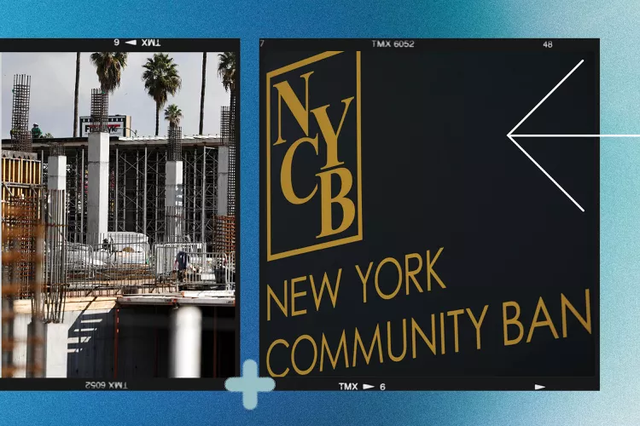By Christiana Sciaudone
March 11, 2024
KEY TAKEAWAYS
- One year after the collapse of Silicon Valley Bank, turmoil at New York Community Bank has put investors and consumers on notice of the perils that regional banks continue to face.
- Regional banks have high exposure to commercial real estate loans that could be problematic as interest rates remain at a two-decade high.
- Earnings are likely to suffer as banks struggle to shore up liquidity, experts say, but an industry-wide panic isn’t expected to materialize.
The recent turmoil at New York Community Bank (NYCB) has served as a reminder of the problems that regional banks continue to face one year after the collapse of Silicon Valley Bank and others.
High interest rates and commercial real estate loan exposure still pose problems for many regional banks—and some institutions face particular risks—but experts don’t expect widespread failures.

“Most of the disruption that was driven by sharp and quick rate increases—that’s played out,” said Chris McGratty, a managing director at Keefe, Bruyette & Woods, referring to the Federal Reserve’s inflation-fighting effort that has pushed its benchmark interest rate to a 23-year high.
Federal Reserve Chair Jerome Powell, speaking during congressional testimony on Wednesday, acknowledged that some banks will face losses, but said his team is working closely with institutions that may face trouble.
“It’s going to be with us as a problem we’ll be working through I think for several years,” Powell said. “The idea is you’ve got to have enough capital, enough liquidity and a plan to take the losses that you’re probably going to take.”
Still, the chief U.S. central banker doesn’t see a systemic issue pending. “I am confident that we’re doing the right things there. And I do believe it’s a manageable problem. If that changes, then I’ll say so.”
NYCB Seen as Outlier But Not Completely Alone
The latest round of fears about regional banks was kicked off in late January when NYCB reported a surprise fourth-quarter loss of $260 million, significantly raised its provisions for credit losses and slashed its quarterly dividend by 70% to 5 cents a share. In the past week, the bank announced a write-off of an additional $2.4 billion loss, received a $1 billion capital injection, cut its dividend to one cent and committed to scaling back its commercial real estate holdings.
NYCB shares have lost two-thirds of their value since the start of the year, with particularly steep drops on certain days pulling shares of other regional banks lower.
But NYCB is seen as facing particular challenges because of its heavy exposure to a specific segment of the commercial real estate lending universe.
“New York Community Bank is at the worst end of the risk spectrum,” regarding high interest rates, according to David Chiaverini of Wedbush Securities. It is unique because it is most exposed to highly regulated rent-controlled multifamily housing buildings in New York that are struggling to make money.
As of the end of December, NYCB had an $18.3 billion portfolio of loans made to rent-regulated multifamily buildings in New York City, equivalent to roughly 22% of all of the bank’s loans.
Analysts have so far categorized NYCB as an outlier but other banks with loan exposure to rent-regulated multifamily units, as well as other forms of commercial real estate, could face challenges.
Owners of offices, malls, self storage and other commercial real estate in some cases are facing empty spaces with no rent coming in while also seeing loans maturing, meaning they have to refinance at higher rates. Their ability to cover debt service costs is more limited with the higher interest costs, Chiaverini said.
Commercial real estate is the number one asset that banks with under $50 billion in assets lend to, with roughly 40% of loan portfolios in the segment, KBW’s McGratty said. That large exposure means pain and risk from it aren’t going away any time soon.
Regional Bank Earnings Remain Under Pressure
While that pain may not translate into collapses such as those a year ago, it will take a toll on earnings of regional banks.
“We’re a little bit more cautious because we don’t see the crises like we saw last year, but there’s still earnings pressures in the system,” KBW’s McGratty said in an interview. “There’s still margin pressure, there is still slowing growth. And we’re still in the process of credit normalizing higher.”
He’s not the only one who is betting on that scenario.
“My base case is that the banks survive and get through it,” said Peter Winter of DA Davidson. “But it’ll be a headwind to earnings growth.”
Spectrum Wealth Management, LLC is an investment adviser registered with the U.S. Securities and Exchange Commission. Registration does not imply a certain level of skill or training. Additional information about Spectrum’s investment advisory services is found in Form ADV Part 2, which is available upon request. The information presented is for educational and illustrative purposes only and does not constitute tax, legal, or investment advice. Tax and legal counsel should be engaged before taking any action. The opinions expressed and material provided are for general information and should not be considered a solicitation for purchasing or selling any security.